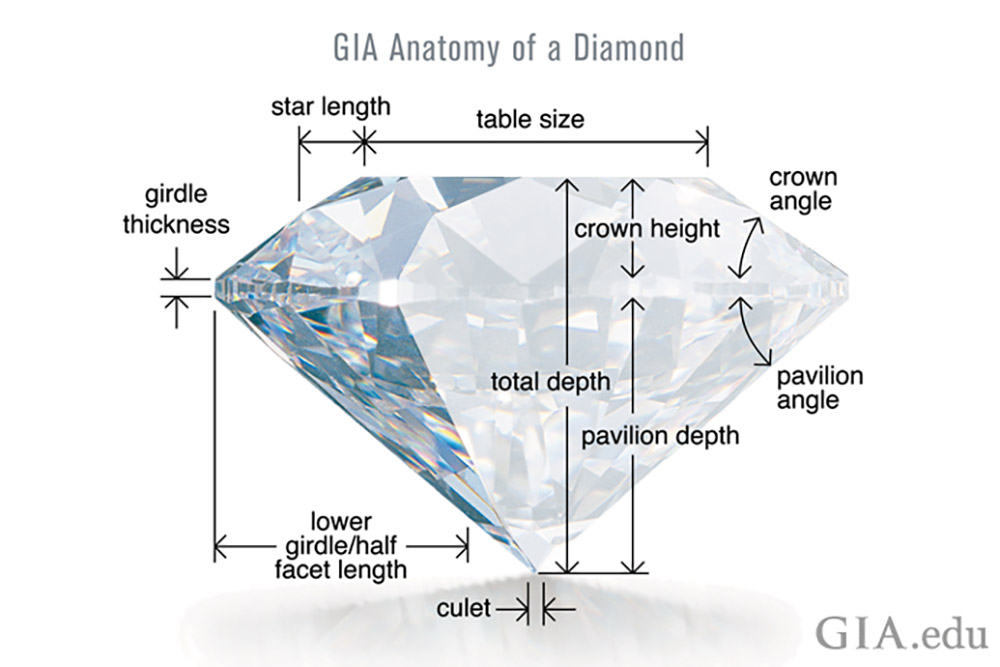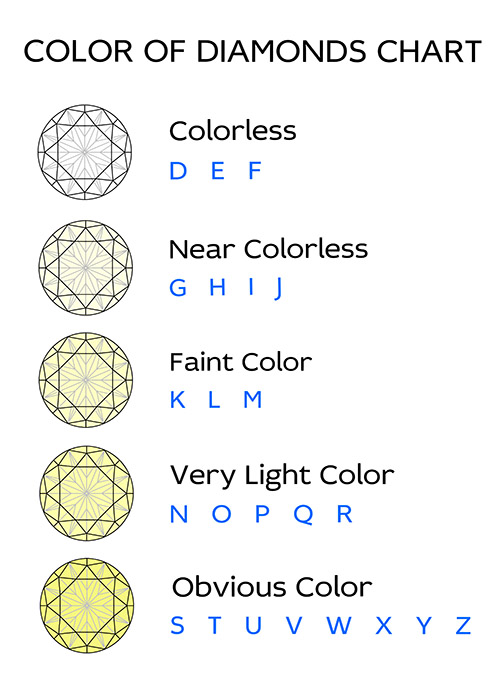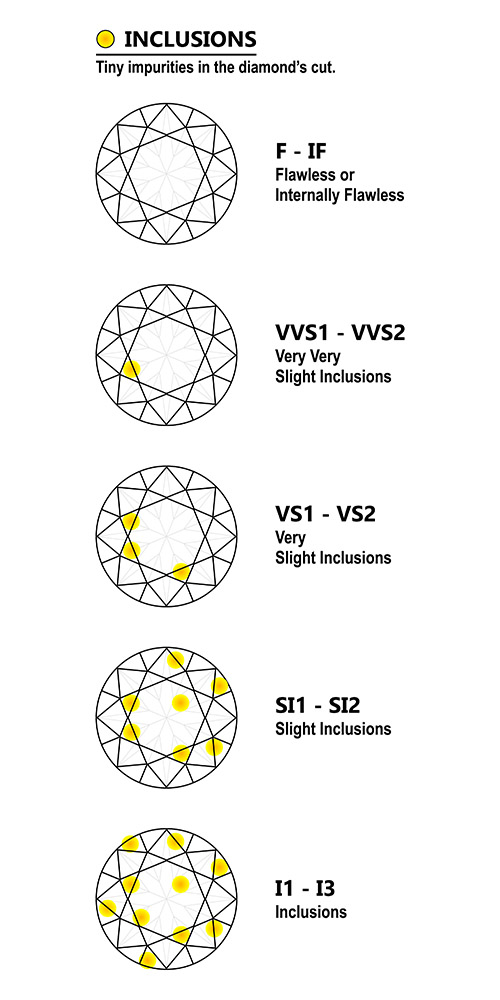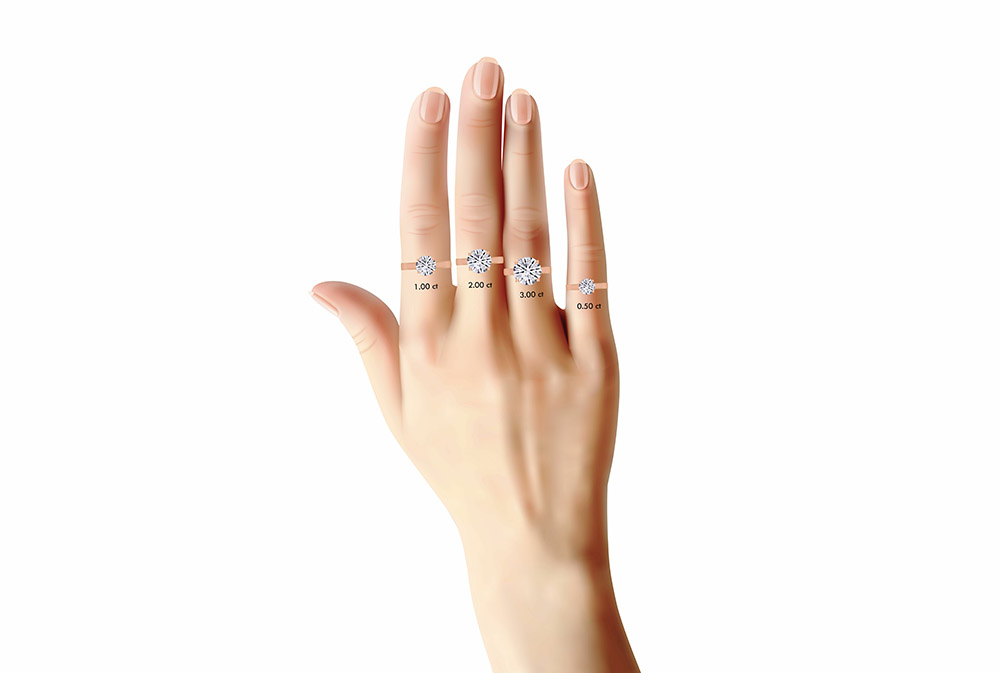We all love and adore diamonds and their brilliance, but in order to truly worship this wonderful gemstone we first need to understand them. With the four C’s we can!
If someone you love is getting a diamond engagement ring soon, it’s a good idea to brush up on the basics. The 4C’s of a diamond is an easy and memorable way to understand diamond fundamentals.
By learning about the 4 Cs of diamonds (Cut, Clarity, Color, and Carat), you’ll be:
- Better prepared to choose the perfect ring for that special someone
- Well-versed in diamond and jewelry lingo
- Saving yourself time, money, and second guesses
In this article you will learn exactly what you need to know to be both an educated diamond shopper and lover.
What are the 4 Cs of Diamonds?
The 4Cs are the universal standard for judging a diamond’s quality. Each “C” represents a different characteristic that influences the overall look and value of your gem. They are:
- Cut: How well the diamond reflects light.
- Clarity: The number and visibility of imperfections.
- Color: The presence or absence of yellow tint.
- Carat weight: The total weight or size of the diamond.
Understanding these four factors can help you make more informed and confident decisions when choosing your next brilliant, everlasting diamond.
In the sections below, we’ll break down each C, what it means, why it matters, and how to choose what’s right for you.
Cut


When it comes to diamond quality, Cut may be the most important of the 4 Cs and also one of the most misunderstood. While many shoppers confuse cut with shape (like round, oval, or princess), diamond cut actually refers to how well a diamond reflects light. This directly impacts its brilliance, sparkle, and visual appeal.
If you’re wondering what diamond cut has the best sparkle, this is the section for you.
What Does “Diamond Cut” Really Mean?
In simple terms, a diamond’s cut grade determines how much light is reflected back to the viewer’s eye. It’s the craftsmanship behind the stone—the angles, depth, symmetry, and polish that create its inner fire.
- A well-cut diamond sparkles brilliantly, appearing vibrant and full of life.
- A poorly cut diamond looks dull, even if it has high clarity or color grades.
If you’ve ever searched “why does my diamond look dull?”—chances are the cut is to blame.
Why Cut Quality Matters in a Diamond
A diamond’s cut is about more than just aesthetics—it’s the key to maximizing your stone’s light performance. Master diamond cutters use precise geometry to achieve ideal proportions that let light travel in 3 stages as follows:
- Light enters the diamond
- Light then reflects internally bouncing off the cut’s precise mirror like edges
- Finally, the light bounces back to your eye through the top of the gem.
If the angles are off, light escapes through the sides or bottom, making the diamond look darker or smaller. This is why the cut effects sparkle more than carat weight or even color.
Choosing the Best Diamond Cut
If you’re shopping for an engagement ring that sparkles, prioritize a diamond with an Excellent or Ideal Cut grade. These cuts are designed to maximize brilliance and fire, giving you that “wow” factor.
Whether you're choosing a round brilliant diamond (the most popular and sparkly cut) or a fancy shape like princess or cushion, always check the cut grade first.
A beautifully cut diamond will:
- Appear larger and more brilliant
- Reflect maximum light
- Look more expensive, even if it's a smaller carat
Color
Many people assume diamonds are completely clear, but that’s actually a common misconception. In reality, most diamonds have slight colorations or tints, which come from natural elements present during their formation deep in the Earth.
If you’ve ever wondered, “Why isn’t my diamond perfectly clear?”—you’re not alone. Let's find out why.
Why Diamonds Have Color
Diamonds form over billions of years, and during this time, they may absorb trace elements like nitrogen, which affect their appearance. For example, excess nitrogen can cause a yellowish hue in the diamond.
These natural imperfections and subtle color tones are not necessarily “flaws”; they're part of what makes each diamond unique. But they do play a role in how diamonds are graded, priced, and perceived.
The Diamond Color Scale: D to Z Explained
To measure how much color a diamond has, us jewelers use the official diamond color grading scale, established by the Gemological Institute of America (GIA). This scale ranges from D to Z as seen in the chart.
D-Z scaling is a spectrum of clarity and tint, with diamonds gradually becoming more colored as you move down the alphabet. Most diamonds used in jewelry fall somewhere between D and J.
- D-grade diamonds are completely colorless: icy, rare, and highly valuable.
- Z-grade diamonds have noticeable yellow or brown tints, making them less rare and generally more affordable.


Clarity
When it comes to buying a diamond, Clarity is one of the key 4 Cs that determine a stone’s value, beauty, and uniqueness. But many shoppers ask, “What is diamond clarity?” or “Does clarity grade really matter?”
Let’s dive in and answer all these important questions!
What Is Diamond Clarity?
Diamond clarity refers to the presence (or absence) of natural imperfections within a diamond. These internal flaws are called inclusions, while external blemishes are referred to as surface imperfections.
Clarity evaluates how many of these flaws a diamond has, how visible they are, and how they affect the diamond’s overall appearance.
Think of it as the diamond’s unique “Fingerprint” or “Snowflake”.
No two diamonds are exactly alike, and some level of imperfection is completely normal.
How Do Inclusions Affect a Diamond?
Inclusions can range from tiny black carbon spots to feather-like cracks or cloudy areas inside the brilliant diamond. Some are so small they can only be seen under a microscope, while others might be visible to the naked eye.
If you’re wondering, “Will I see the inclusions in my diamond?”, that depends on the clarity grade. The best diamonds are the unique ones anyway, ones that have a story. These inclusions are like the rings of a great oak tree, a sign of its age and history, and magnificence.
- Flawless diamonds (FL) have no visible inclusions even under 10x magnification.
- Included diamonds (I1–I3) have flaws you may see without magnification.


How is your diamond’s clarity graded
Assessing the clarity of the diamond boils down to the general quantity of the inclusions present in your diamond as well as their size and volume. The positioning of the blemishes also factors into its rating as a poorly placed blemish could be potentially distracting.
Here is a chart for easy reference:
Diamond Clarity Grades
| Rating | What they stand for | What do they mean |
| FL | Flawless | This diamond has no inclusions. You are a very lucky person! |
| FI | Internally Flawless | Defined as having no inclusions. But may have microscopic blemishes on the diamond's surface. |
| VVS1 and VVS2 | Very, Very Slightly Included | Have barely any inclusions. Very difficult even for an expert diamond grader to find under a microscope. |
| VS1 and VS2 | Very Slightly Included | With experience you can see the blemishes under a 10x microscope |
| SI1 and SI2 | Slightly Included | Blemishes can be found when looking under a 10x microscope |
| I1, I2, I3 | Included | Blemishes are obviously present when looking under a 10x microscope |
Don’t Fall for the Clarity Trap
There exists a common misconception that many diamond jewelry shoppers fall victim too. Some believe they need the highest clarity grade possible, like a Flawless (FL) diamond, to get a brilliant stone. But this is in fact not the case.
Flawless diamonds are in fact the best of their grade, and the tip of the diamond quality food chain, but that doesn't mean an SI or even an SI2 is inferior.
The truth is diamond clarity does not equate to sparkle. A lot of the inclusions in diamonds are very hard to see with the naked eye.
Think of it this way, you will most likely never see any of the inclusions in your SI-graded diamond because you won't be looking at the diamond under a microscope on a daily basis. Plus, some people want diamonds with inclusions because each speck tells a story!


Carat
The last but certainly not least of the 4’c quartet is Carat!
Carat is our unit of measurement that quantifies a diamond's weight and apparent size. Just take a look at how different carats have vastly different effects on the hand in the image.[1] [2]
Note: Carat weight isn't the only fact that alters the size of your diamond. The other C’s like a diamond’s cut and shape also play a huge role in how big or small it actually appears.
What is Total Carat Weight (TCW)
If you’ve asked yourself, “How do I know how much diamond is actually in my ring?”, Total Carat Weight (or TCW) is your answer.
Total Carat Weight is the term we use to describe how much diamond is in a single jewelry setting, not just one stone, but all of them combined.
It’s an easy way to understand how much sparkle you’re really paying for, and how much bang you’re getting for your buck. It’s also a helpful way to compare values between different pieces.
For example:
A ring with a 1.00 TCW might have a single 1-carat diamond. But another ring with 1.00 TCW could have ten 0.10-carat diamonds instead.
Both technically contain the same total carat weight, but the appearance and price can vary greatly depending on how the weight is distributed.
How is carat weight measured
One carat for a diamond weighs about 0.2 grams or 200 mg. This is very light and roughly about 1/10th of a paperclip or the weight of an average raindrop. This measurement is standard everywhere across all countries to maintain consistency.
What Are Points in Diamond Carat?
Have you ever heard a jeweler or a friend mention that their diamond has “x” amount of points? If so, you were probably confused and just nodded your head assuming that meant something good.
Thankfully we have the answer. Using carats, diamonds are measured in points, especially when we are dealing with smaller size differences in diamonds.
- 1 carat = 100 points
- So, 0.1 carat = 10 points
- 0.25 carat = 25 points
- And so on...
This system makes it easier for jewelers and shoppers to talk about fine differences in size. Here are some example conversions:
- 50 points = 0.50 carats
- 100 points = 1.00 carat
- 200 points = 2.00 carats
- 300 points = 3.00 carats



